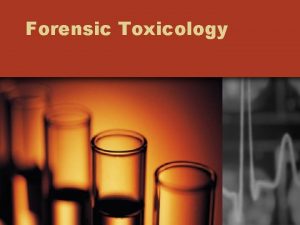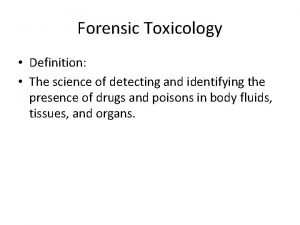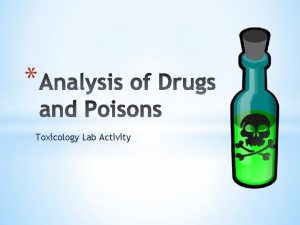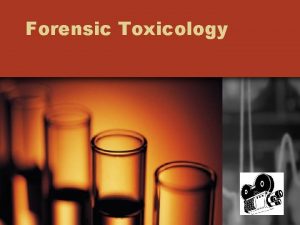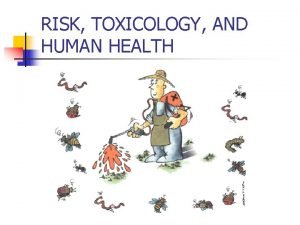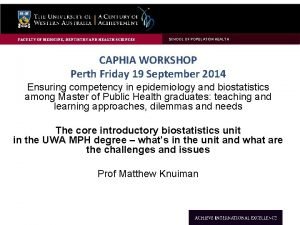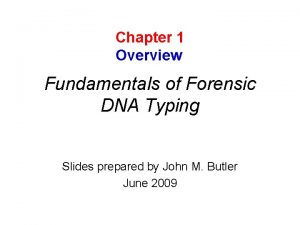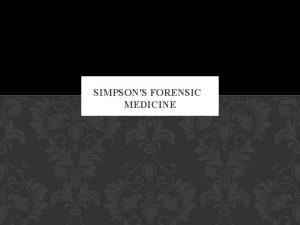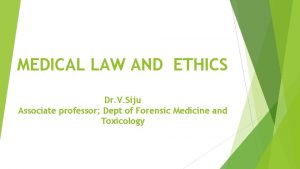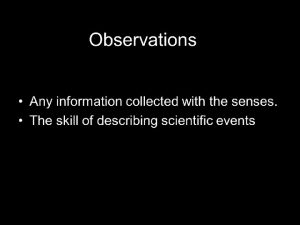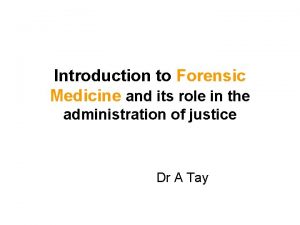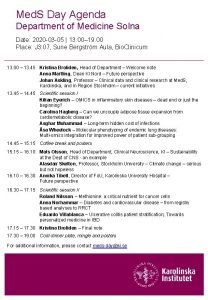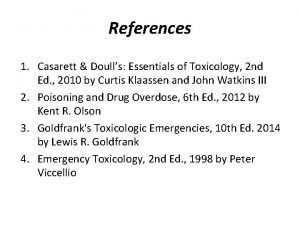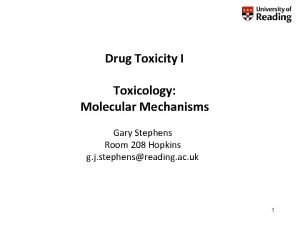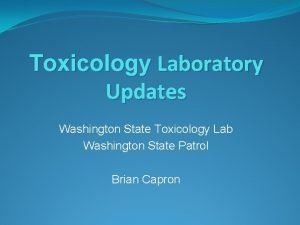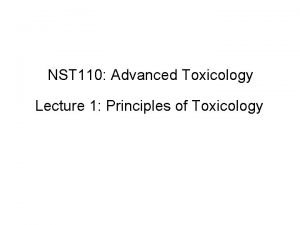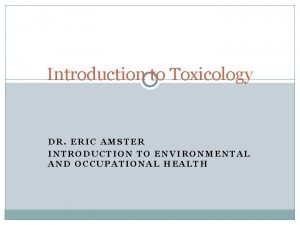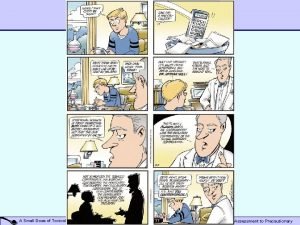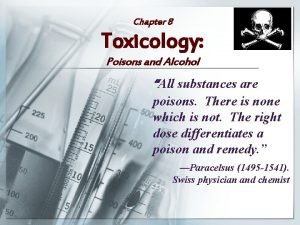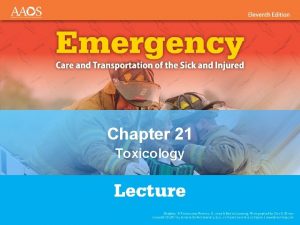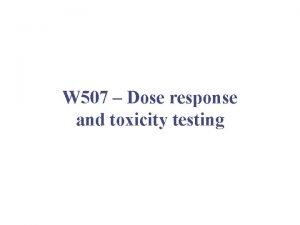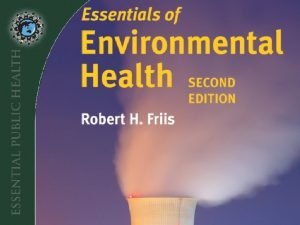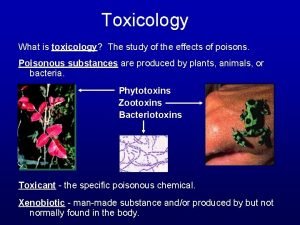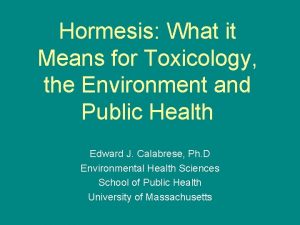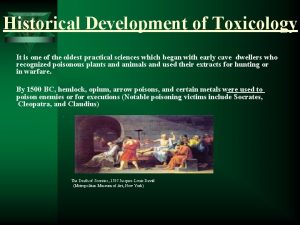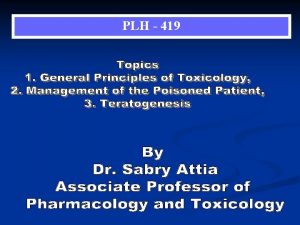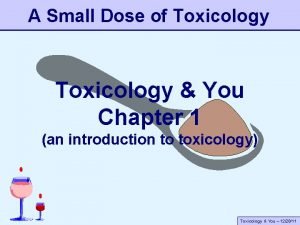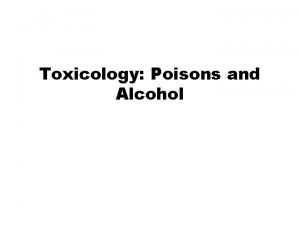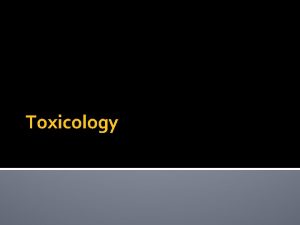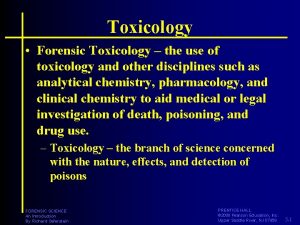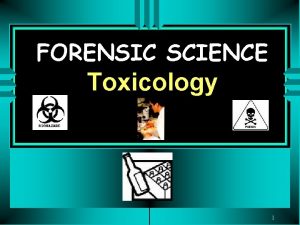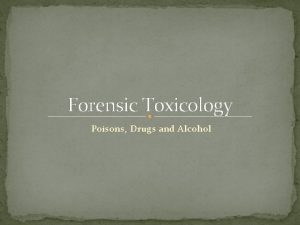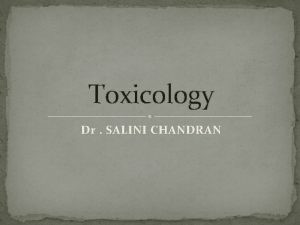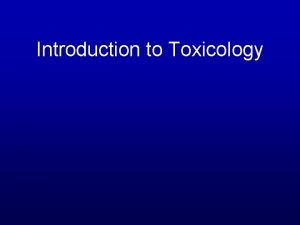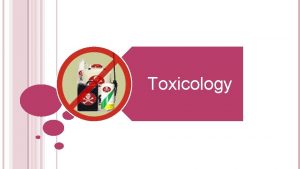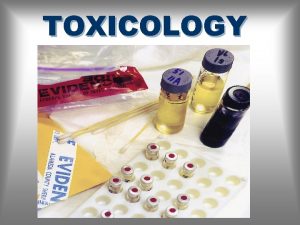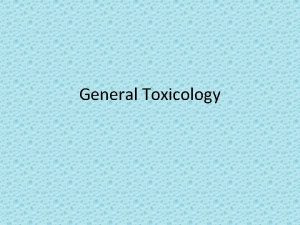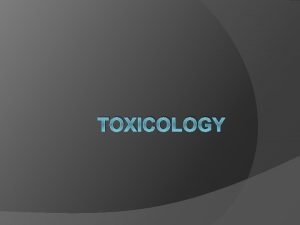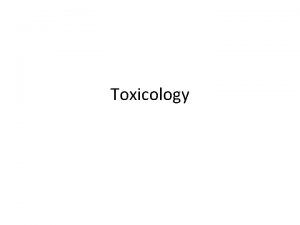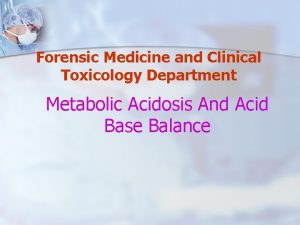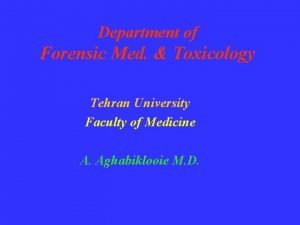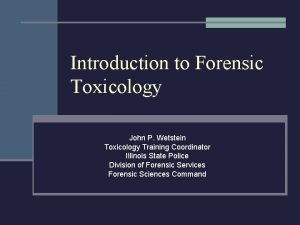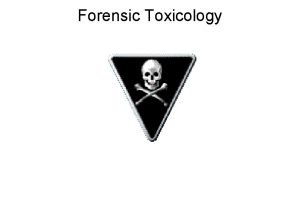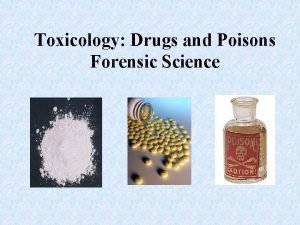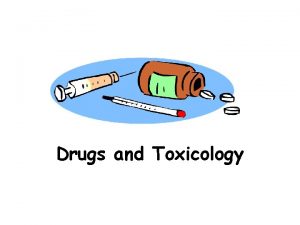Fundamentals of toxicology Forensic Medicine Toxicology Department Faculty























































- Slides: 55

Fundamentals of toxicology Forensic Medicine &Toxicology Department Faculty of Vet. Medicine South Valley University

Toxicology Is the science concerned with the study of poisons, including: Sources, physical and chemical properties. Kinetics and dynamics. Methods of Diagnosis and treatment.

Poison (toxicant): Any substance when introduced into the body or applied from outside interferes with biological processes of cells of living organisms by its inherent properties (without involvement of mechanical or thermal action).

Toxin (biotoxin): Poison produced by biological organism (plant, animal or microbial)

Venom: Toxins formed by venomous animals and must be injected to do its action as it is protein in nature, if given orally it will be digested.

Poisoning (intoxication or toxicosis) o The disease state caused by the poison.

Toxic o A term which describes the harmful effects of a poison on a living system.

Toxicity o The capacity of a chemical to produce injury.

Expressing toxicity Toxicity is expressed as the amount of poison that produces a harmful effect under specific conditions (dose response relation ship:

1) Dose o The total amount of poison (mg) received per animal.

2) Dosage o The amount of poison (mg) per kg of animal body weight, i. e. , (mg/kg).

Threshold dose: o. The lowest dose causing death.

4) Median lethal dose Lethal dose 50 (LD 50) o The dose which kills 50% of animals.

5) LD 1 and LD 99 o The doses which kill 1% and 99% of animals, respectively.

Lethal concentration LC: The lowest lethal concentration of a compound in air water and feeds for some species as wild life and fish

6) Median lethal concentration (LC 50) The concentration of a chemical (ppm or ppb) in food, water or air causing death of 50% of animals, fish or birds.

Expressing safety of a compound: 1) Therapeutic index (TI) 2) Standard safety margin

ED 50 (median effective dose) q is the dose of a drug which produces therapeutic effect in 50% of animals.

1) Therapeutic index (TI): Therapeutic index (TI) = LD 50 / ED 50

2) Standard safety margin (SSM) = LD 1 / ED 99 SSM is more accurate than the TI.

Evaluation of unknown compound toxicity: I-Estimation of the LD 50 of this compound in male albino rats by the oral rout. LD 50 and the table of Hodge and Sterner (1949) as following: II-compare the calculated

(Oral LD 50 in rats, mg/kg) Class LD 50 (rat) <5 1) Supertoxic Example Strychnine 2) Extremely T 5 - 50 Opium 3) Very T 50 - 500 Phenobarbitone 4) Moderately T 500 - 5000 5) Slightly T 5000 - 15000 Ethanol 6) Practically non-toxic >15000 Kerosene Linseed oil

Classification of poisons Poisons are classified according to:

1) The source: Plant poisons Animal poisons Metallic poisons Synthetic poisons

2) Physical nature Gases Liquids Solids

3) Chemical structure salts Acids Alkalis Proteins Glycosides Alkaloids

4)Target Organ affected (Site of action) Hepatotoxicants Neurotoxicants Nephrotoxicants Cardiotoxic, etc.

6) Type of action Poisons with only a local action (corrosives): Mineral acids : HCl, H 2 SO 4, HNO 3. Alkalis: Na. OH, KOH. Some salts: Antimony trichloride, barium chloride. Poisons with only a remote action: They act after absorption, e. g. , strychnine. Poisons with double action (local + remote): Irritant poisons = (metals, except the 2 salts mentioned before). Organic acids (carbolic, oxalic and hydrocyanic).

Causes of toxicity in animals: A) Natural toxicants B) Man-made toxicants

A) Natural toxicants Classified according to their origin into: o Inorganic materials o Poisonous plants o Mycotoxins o Venomous animals

B) Man-made toxicants o o o ü ü ü Feed additives Over dose of drugs Environmental pollutants Agricultural activities (pesticides) Industrial activities Military activities

Expressing toxic effects They are expressed according to frequency and duration of exposure.

1) Acute toxicity Describes the effects of a single or few large doses or high conc. Of a poison given during 24 hours up to 96 hours.

2) Subacute toxicity Describes the effects of several doses relatively smaller than that of acute toxicity given within few to 30 days.

3) Subchronic toxicity Describes the effects of exposure to repeated small doses given for 1 -3 months.

4) Chronic toxicity Refers to the toxic effects produced by prolonged exposure (>3 months).

Chronicity factor = Acute (single dose) LD 50 / chronic (90 day) LD 50 When its value is "1", it indicates compounds are metabolized and eliminated in the same manner regardless of the duration of exposure, and the lethal dose does not change appreciably i. e. ; Acute LD 50 = chronic LD 50. it indicates a rapidly metabolizing poison e. g. Caffeine : has chronicity factor of 1. 3 When its value is more than 2, it indicates cumulative poison Acute LD 50 > chronic LD 50. e. g. Warfarin: has chronicity factor of 20.

The biologic system may develop tolerance so that after prolonged exposure, a higher dose may be tolerated Acute LD 50 < chronic LD 50. e. g. potassium cyanide CF= Acute (single dose) LD 50(10) / chronic (90 day) LD 50(250) = 0. 04.

Factors affecting toxicity: Factors related to the toxicant: Dose: Physical state: Chemical formulation: Route of exposure: Exposure to more than one toxicant:

Factors related to the animal: Age: Species: Health state: Sex:

Factors related to both the toxicant and the animal: Idiosyncrasy: Tolerance:

Factors related to the environment: Environmental temperature: Nutritional factor:

General Line of Treatment of Toxicity

Supp. & sympt. treatment Using antidotes Prevention of further exposure Elimination of the Absorbed part Prevention of further absorption

1 -Prevention of further absorption:

2 -Prevention of further absorption: eye Emesis skin GIT Gastric lavage lungs injection purgatives

• poison Charcoal grain

3 -Elimination of the Absorbed part lungs kidney GIT Gut dialysis Diuretics Fluid Forced Acid alkaline

4 -using of antidotes: adsorbent neutralizing atropine diluents oxidizing Demulcent= coaters reducing Eserine or physostigmine barbiturates precipitating solvents Specific =chelating agents entanglers EDTA Vit. K Digitalis delayers BAL pharmacological chemical physical DMSA D-Penicillamine oximes antisera

5 -supportive &symptomatic treatment





 Forensic toxicology definition
Forensic toxicology definition Forensics toxicology definition
Forensics toxicology definition Who is regarded as the father of forensic science?
Who is regarded as the father of forensic science? Forensic toxicology lab activity
Forensic toxicology lab activity Forensic toxicology definition
Forensic toxicology definition Forensic toxicology vocabulary
Forensic toxicology vocabulary Forensic anthropologist vs forensic pathologist
Forensic anthropologist vs forensic pathologist Who is this
Who is this Semmelweis university faculty of medicine
Semmelweis university faculty of medicine Cairo university faculty of veterinary medicine
Cairo university faculty of veterinary medicine Faculty of veterinary medicine cairo university logo
Faculty of veterinary medicine cairo university logo Faculty of veterinary medicine cairo university
Faculty of veterinary medicine cairo university Faculty of medicine nursing and health sciences
Faculty of medicine nursing and health sciences Auricle of heart vs atrium
Auricle of heart vs atrium Hacettepe university faculty of medicine
Hacettepe university faculty of medicine Faculty of medicine dentistry and health sciences
Faculty of medicine dentistry and health sciences King abdulaziz university faculty of medicine
King abdulaziz university faculty of medicine Semmelweis university faculty of medicine
Semmelweis university faculty of medicine Hubert kairuki memorial university faculty of medicine
Hubert kairuki memorial university faculty of medicine Coumadin clinic emory
Coumadin clinic emory Territorial matrix vs interterritorial matrix
Territorial matrix vs interterritorial matrix Department of medicine mcgill
Department of medicine mcgill Fundamentals of forensic dna typing
Fundamentals of forensic dna typing Forensic science fundamentals and investigations chapter 6
Forensic science fundamentals and investigations chapter 6 Nit calicut chemistry faculty
Nit calicut chemistry faculty Positional asphyxia positions
Positional asphyxia positions Dr rubina yasmin
Dr rubina yasmin Simpsons forensic medicine
Simpsons forensic medicine Dichotomy forensic medicine
Dichotomy forensic medicine 1806 valentin ross
1806 valentin ross Introduction to forensic medicine
Introduction to forensic medicine Department of forensic science dc
Department of forensic science dc Department of medicine solna
Department of medicine solna Toxicology management
Toxicology management Toxicology effects
Toxicology effects Nc ocme
Nc ocme Toxicology
Toxicology Environmental toxicology definition
Environmental toxicology definition Drug identification and toxicology
Drug identification and toxicology Annual review of pharmacology and toxicology
Annual review of pharmacology and toxicology Washington state patrol toxicology lab
Washington state patrol toxicology lab Nst 110
Nst 110 Toxicology
Toxicology Toxicology
Toxicology Chapter 8 toxicology poisons and alcohol
Chapter 8 toxicology poisons and alcohol Chapter 21 toxicology
Chapter 21 toxicology W 507
W 507 Toxicology definition
Toxicology definition What is toxicology?
What is toxicology? Hormesis
Hormesis Examples of toxicology
Examples of toxicology Toxicology defination
Toxicology defination Toxicology types
Toxicology types A small dose of toxicology
A small dose of toxicology Toxicology effects
Toxicology effects Toxicology and applied pharmacology
Toxicology and applied pharmacology
